
France began colonizing the Americas in the 16th century and continued into the following centuries as it established a colonial empire in the Western Hemisphere. France established colonies in much of eastern North America, on several Caribbean islands, and in South America. Most colonies were developed to export products such as fish, rice, sugar, and furs.

The Huguenots were a religious group of French Protestants who held to the Reformed (Calvinist) tradition of Protestantism. The term, which may be derived from the name of a Swiss political leader, the Genevan burgomaster Besançon Hugues (1491–1532), was in common use by the mid-16th century. Huguenot was frequently used in reference to those of the Reformed Church of France from the time of the Protestant Reformation. By contrast, the Protestant populations of eastern France, in Alsace, Moselle, and Montbéliard, were mainly Lutherans.

Darien is a city in and the county seat of McIntosh County, Georgia, United States. It lies on Georgia's coast at the mouth of the Altamaha River, approximately 50 miles south of Savannah, and is part of the Brunswick, Georgia metropolitan statistical area. It is the second-oldest planned city in Georgia and was originally called New Inverness. The population of Darien was 1,460 at the 2020 census, down from 1,975 in 2010.

East Florida was a colony of Great Britain from 1763 to 1783 and a province of the Spanish Empire from 1783 to 1821. The British gained control over Spanish Florida in 1763 as part of the Treaty of Paris which ended the Seven Years' War. Deciding that the colony was too large to administer as a single unit, British officials divided Florida into two colonies separated by the Apalachicola River; the colony of East Florida, with its capital located in St. Augustine and West Florida with its capital located in Pensacola. East Florida was much larger and comprised the bulk of the former Spanish colony and most of the current state of Florida. It had also been the most populated region of Spanish Florida, but before control was transferred to Britain, most residents – including virtually everyone in St. Augustine – left the territory, with most migrating to Cuba.
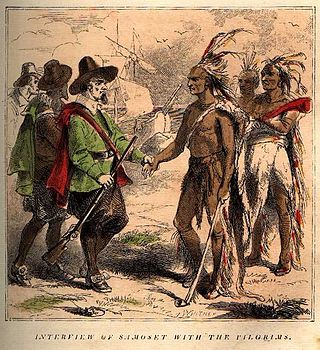
The colonial history of the United States covers the period of European colonization of North America from the early 16th century until the incorporation of the Thirteen Colonies into the United States after the Revolutionary War. In the late 16th century, England, France, Spain, and the Dutch Republic launched major colonization expeditions in North America. The death rate was very high among early immigrants, and some early attempts disappeared altogether, such as the English Lost Colony of Roanoke. Nevertheless, successful colonies were established within several decades.
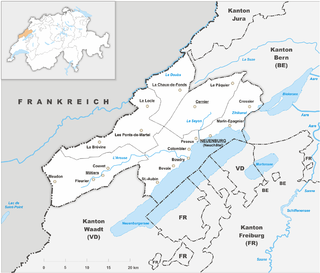
The Republic and Canton of Neuchâtel is a mostly French-speaking canton in western Switzerland. In 2007, its population was 169,782, of whom 39,654 were foreigners. The capital is Neuchâtel.

The Province of North Carolina, originally known as Albemarle Province, was a proprietary colony and later royal colony of Great Britain that existed in North America from 1712 to 1776.(p. 80) It was one of the five Southern colonies and one of the thirteen American colonies. The monarch of Great Britain was represented by the Governor of North Carolina, until the colonies declared independence on July 4, 1776.

Neuchâtel is a town, a municipality, and the capital of the Swiss canton of Neuchâtel on Lake Neuchâtel. Since the fusion in 2021 of the municipalities of Neuchâtel, Corcelles-Cormondrèche, Peseux, and Valangin, the city has approximately 33,000 inhabitants. The city is sometimes referred to historically by the German name Neuenburg; both the French and German names mean "New Castle".
John Bull was an American statesman and revolutionary who served as a delegate from South Carolina in the Continental Congress from 1784 to 1787.

Boudry is a municipality in the canton of Neuchâtel in Switzerland.

Glay is a commune in the Doubs department in eastern France. It is located in the Jura mountains near the border with Switzerland.

The colonial period of South Carolina saw the exploration and colonization of the region by European colonists during the early modern period, eventually resulting in the establishment of the Province of Carolina by English settlers in 1663, which was then divided to create the Province of South Carolina in 1710. European settlement in the region of modern-day South Carolina began on a large scale after 1651, when frontiersmen from the English colony of Virginia began to settle in the northern half of the region, while the southern half saw the immigration of plantation owners from Barbados, who established slave plantations which cultivated cash crops such as tobacco, cotton, rice and indigo.

Scottish colonization of the Americas comprised a number of failed or abandoned Scottish settlements in North America; a colony at Darien on the Isthmus of Panama; and a number of wholly or largely Scottish settlements made after the Acts of Union 1707, and those made by the enforced resettlement after the Battle of Culloden and the Highland Clearances.
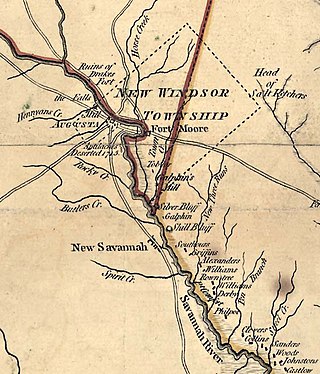
Savannah Town, South Carolina is a defunct settlement that was located in the colonial years on the Savannah River below the Fall Line in present-day Aiken County. In the 1670s the Westo had a village here, but they were displaced by the Savannah in a trade war, and it became known by 1685 as Savannah Town. The English colony had traders who did a lucrative business in dressed skins with the Savannah Shawnee. Fortified as a frontier post, the settlement developed and ferry service was established across the river. The town was gradually overtaken by its competitor of Augusta, Georgia, established in 1735 five miles upriver and closer to Indian settlements. Traders here intercepted commerce, sending it to their port of Savannah on the coast. By 1740 Savannah Town was declining, and by 1765 the village was abandoned and the fort closed.
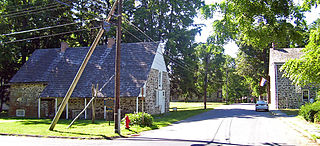
Historic Huguenot Street is located in New Paltz, New York, approximately 90 miles (140 km) north of New York City. The seven stone houses and several accompanying structures in the 10-acre National Landmark Historic District were likely built in the early 18th century by Huguenot settlers fleeing discrimination and religious persecution in France and what's now southern Belgium. After negotiating with the Esopus Indians, this small group of Huguenots settled on a flat rise on the banks of the Wallkill River in 1678. The settlers named the site in honor of Die Pfalz, the region of present-day Germany that had provided them temporary refuge before they came to America. Archaeological finds indicate that the immediate area settled by the Huguenots was occupied by Native Americans prior to European contact. The site is one of the oldest continuously inhabited settlements in the United States.

Fort King George State Historic Site is a fort located in the U.S. state of Georgia in McIntosh County, adjacent to Darien. The fort was built in 1721 along what is now known as the Darien River and served as the southernmost outpost of the British Empire in the Americas until 1727. The fort was constructed in what was then considered part of the colony of South Carolina, but was territory later settled as Georgia. It was part of a defensive line intended to encourage settlement along the colony's southern frontier, from the Savannah River to the Altamaha River. Great Britain, France, and Spain were competing to control the American Southeast, especially the Savannah-Altamaha River region.

The Hôtel DuPeyrou is a mansion in the city of Neuchâtel, Switzerland.
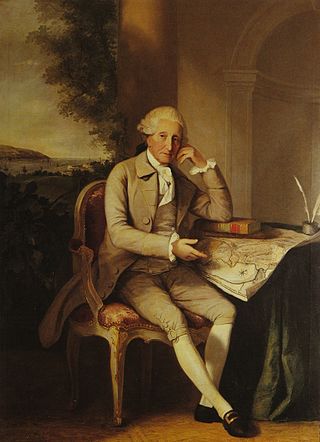
David de Pury, Baron de Pury was a Swiss banker, merchant, and philanthropist. His involvement in Triangular trade, particularly diamond and precious wood trading between Europe and South America, earned him a vast fortune. He became a major benefactor for his home town, Neuchâtel, where he funded the construction of schools, hospitals, government buildings, and served as a patron of various local charities. De Pury has become a controversial figure in the 21st-century for his connection to the Atlantic slave trade through his business endeavors in Latin America.
Jean-Pierre Pury was an explorer, geographer and colonist from the Principality of Neuchâtel, a Prussian principality in modern-day Switzerland. He served as mayor of Lignières and worked as a wine merchant before losing his wealth to a fire. He then worked as a corporal for the Dutch East India Company, which inspired him to found his own colony. After years of campaigning, he was granted permission by the British Crown to establish a settlement in the Province of Carolina. He established the Colony of Purrysburg and lived as a planter on 12,000 acres. His colony, made up of mostly Swiss Protestants, was relatively unsuccessful.
Baron Roland de Pury was a Swiss Protestant theologian, pastor, and writer. Living in France during World War II, he was a staunch opponent of Nazism and the Holocaust and publicly criticized and preached against the Vichy French government and German occupation of France. De Pury joined the French Resistance and organized an escape route for Jewish refugees to leave France and enter Switzerland, hiding them in his home before helping them to the French-Swiss Boarder. He collaborated with French Catholic leaders, including Pierre Chaillet, to rescue Jews. His operation was discovered by the Gestapo, leading to his arrest and imprisonment at Montluc prison. De Pury and his wife were honored as Righteous Among the Nations by Yad Vashem for their efforts to save Jews during the Holocaust. After the war ended, de Pury worked as a missionary in Africa, where he opposed French colonial rule and denounced torture and other violent practices used during the Algerian War.

















